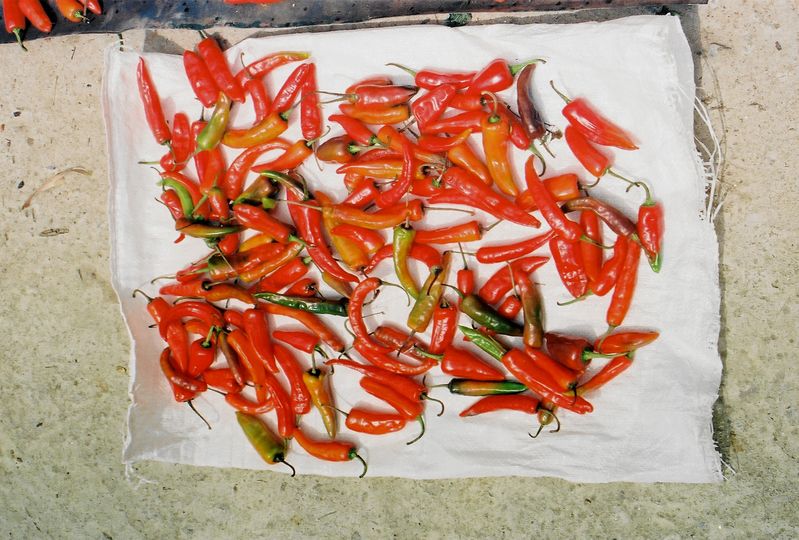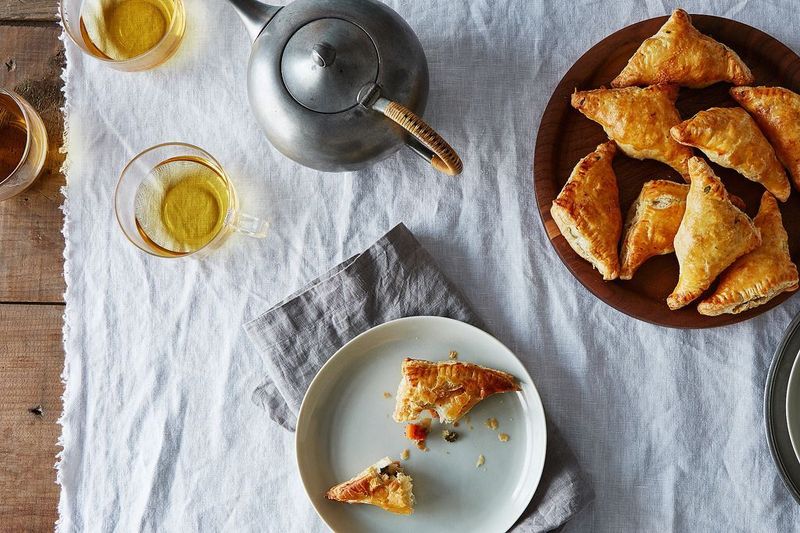In 2004, then-Editor-in-Chief of Gourmet magazine Ruth Reichl warned James Truman, then-Editorial Director of her publisher, Condé Nast, that on his upcoming trip to Bhutan, he would encounter “the world’s worst cuisine.” It was so bad, she said, that she’d heard the tiny Himalayan kingdom’s then-monarch Jigme Singye Wangchuck wanted to hire Thai chefs to invent less miserable national dishes for the nation’s growing tourist base. Her proclamation created a persistent and ruling preconception that Americans writing about Bhutanese food have faced ever since: that the country’s cuisine is a boiled, bland mess from the mountains, that’s sometimes hot and salty, but rarely flavorful.
But as Truman and other expeditionary eaters have learned, Reichl was way off base. The tiny and remote country’s valleys are very fertile. They yield gobs of fibrous red rice, a unique staple that pairs well with foraged mushrooms and ferns, or with the face-melting chiles that define the nation to its neighbors. These chiles are the undeniable key to Bhutanese food, grown and imported in varying shapes, sizes, and colors, but united by their lean towards fire over spice. They’re not just mixed with rice, but into everything, scarfed down like any other vegetable with such enthusiasm that stomach ulcers are an epidemic and a bump in the chile market is enough to cause a national crisis.

Photo by Flickr/avinash singh
Western palates might find Bhutan’s rock-hard cheeses, soupy, salted milk teas, and lesser utilized meats, like tender yak, challenging, but fragrant spices like cardamom, garlic, ginger, and turmeric mingle with onions, potatoes, and tomatoes to create potent, punchy dishes. Meals often show up as a series of small plates, all accompanied by a huge pot of rice to share, so they’re an ideal set up for first-timer exploration. And with dishes like ema datsi, a delightfully gory mix of melted cheese and chopped chiles, Bhutanese cuisine isn’t far off from aligning with American taste buds.
Happy place. Happy food! #folkheritagemuseum in #thimphu #emadatsi #yums
A post shared by Harsh Sethia (@harshsethia) on Oct 9, 2014 at 8:41am PDT
“I have actually used an ema datsi as a substitute for queso at one of my Super Bowl parties,” Jeff Orlick, a prominent voice in the food scene of Queens, New York, a Himalayan immigrant hub, told me. “The flavors are [familiar], with a few kicks that would wow people.”
Most Americans haven’t had the opportunity to try things like ema datsi, because, as Lucy Long’s definitive 2015 Ethnic American Food Today: A Cultural Encyclopedia attests, there are almost no Bhutanese joints in the US. In fact, while some general Himalayan restaurants present one or two Bhutanese dishes among their multitude of northern Indian, Nepali, and Tibetan offerings, often using woeful ingredient substitutions—softer and spicier jalapeños in place of teary-eyed Himalayan peppers; melted American cheese in place of yak dairy—the experts I spoke to on this subject can count the amount of expressly Bhutanese restaurants on one hand. There’s Ema Datsi in Queens, opened in late 2014 by a Lekay Drakpa, a former Buddhist monk, and a nearby pool hall and bar, Weekender, which also serves solid traditional fare.
The lack of Bhutanese food in the US seems, at first blush, inevitable. Bhutan is a mostly rural, notoriously isolationist nation of about 775,000 people; you wouldn’t expect much of their culinary gnosis to drift our way. But there are over 85,000 Bhutanese nationals living in the US, with small but notable populations in bits of Georgia, Indiana, New York, and a few other states and major cities. The American Bhutanese population actually seems to dwarf the much more visible and well-known American Tibetan population. Yet over the past couple of decades, Tibetan Americans have opened up a number of restaurants in the communities they’ve clustered into; there are almost two dozen in Queens alone. This disparity is puzzling and, for inquisitive taste buds, consternating.
It’s tempting to chalk this up to the fact that most Bhutanese-Americans are newcomer refugees. From the late 1980s through the 1990s, King Singye oppressed the Lhotshampa, a mostly Hindu minority of Nepali origin, claiming that they were not Bhutanese, though many Lhotshampas had lived in Bhutan for centuries. About 150,000 of them were driven out of Bhutan by the 1990s and into refugee camps in Nepal. After nearly two decades of failed negotiations to return them to Bhutan, even under a new king who took power in 2006, the United Nations decided to relocate these refugees starting in 2008. The US took the majority of them, and the population is still finding its feet in a drastically new culture, establishing communities and incomes, while also struggling with endemic and seemingly unique mental health problems.
Devotion #devotion #monks #tashichhodzong #bhutan #buddhism
A post shared by Everywhere But Home (@ewbuthome) on Jun 26, 2017 at 7:01am PDT
Tibetan American communities, on the other hand, have had a few more years to establish themselves, with an influx pouring in as early as the early 1990s, creating communities dense and firm enough to build and sustainably patronize their own restaurants. (Orlick notes that about 80% of the patrons in any Tibetan joint in Queens are Himalayan immigrants.)
“It takes [refugees] well more than a decade before they’ve saved up enough to open a restaurant for themselves,” said Zara Houshmand, an Iranian-American writer raised in the Philippines who has worked often with Tibetan immigrant communities since the early 1990s. She helped Tsering Wangmo, the Tibetan American chef of San Francisco’s renowned (but now-shut) Lhasa Moon restaurant, author an English-language Tibetan cookbook in 1999. “It’s probably going to be more than ten years before you see [Bhutanese Americans] in a position to open restaurants, or even afford to eat at their compatriots’ restaurants.”

by Sarah Jampel
By most accounts, young Bhutanese refugees have adapted well to their new country and secured jobs; in some communities, welfare dependence is minimal. Restaurant work is also, as Houshmand notes, a fairly common early job for immigrant workers to start out in. Ema Datsi’s Drapka, who is not a refugee but emigrated to New York in 2008, opened his restaurant in 2014, spending six years before the shop’s launch as a Subway sandwich artist. Members of the refugee community have talked about opening their own restaurants for years. And there are good import channels for Himalayan ingredients, including Bhutanese red rice, across the US thanks to previous Nepali and Tibetan immigration.
Tenzin Dorjee, the non-Lhotshampa Bhutanese chef behind Himalaya Restaurant in Plattsburgh, New York (a venue serving his native cuisine, but also Nepali and Tibetan food), says some of the refugees have started restaurants—just Nepali ones. Dorjee sees the Lhotshampa as Nepali, not Bhutanese, and argues that their cooking relies more heavily on South Asian spice blends, frying, and heavy sautéing, less on cheese and mountain fare than actual Bhutanese food. He argues that there are perhaps only 1,500 ethnic Bhutanese in New York, and not many more across the US: “The 85,000 people that came here as refugees, they’re all Nepali, so they’re not Bhutanese in the true sense. There may be a portion that do eat typical Bhutanese food, but I do know that the majority of them stick to eating Nepali food.”
by Mayukh Sen
Yet ethnographic accounts of Lhotshampa food note that while it does feature Himalayan spices, it leans into its Bhutanese context, riffing on local ingredients and dishes. Tibetan food in the US, according to Lobsang Wangdu and Yolanda O’Bannon, the couple behind Tibetan food and culture site YoWangdu, draws from the decades-old Tibetan and Indian diaspora traditions, which brought the kick of masala into the mix. It has also been influenced by experimentation with American ingredients and forms; Lobsang says he makes a mean momo burger, remixing the meat stuffing for the famous Himalayan dumpling and thick Tibetan bread. Yet it’s still considered Tibetan food as the people who make it consider themselves Tibetan and their food part of their evolving cultural story. So there’s no reason Lhotshampa immigrants, many of whom consider themselves Bhutanese or a distinct ethnicity, should find themselves subsumed into Nepali cuisine.
The refugees Dorjee’s heard of probably opened outwardly Nepalese restaurants in part for the reason he and other Bhutanese chefs have marketed their kitchens as jointly Bhutanese and Nepali, Tibetan, or general Himalayan: They’re drawing on every influence in their lives. Dorjee is Bhutanese but grew up with Nepali influences, while his wife is Tibetan; many of the refugees in America grew up in Nepal. But it might just have to do with Bhutan’s obscurity, too.
“Anyone who has a political sensibility loves to go to a Tibetan restaurants to support [Tibetans], right?” said O’Bannon. “The world associates His Holiness [the Dalai Lama] with Tibet. So when you see a Tibetan restaurant, people think, ‘oh, Dalai Lama.’” Houshmand added that many Americans have traveled to Tibet or visited the diaspora in India and often look fondly on Tibetan restaurants, which, in many cities, swarm with non-Tibetan patrons as a cultural-spiritual connection point to those experiences. Conversely, explained Orlick, “I don’t know of any defining characteristic that our culture knows about Bhutan other than its existence… It’s just too exotic.”
This isn’t just a Bhutanese issue. “Why do Albanians open pizzerias?” Orlick asked, rhetorically. “Because we don’t know what Albanian food is! If you open a pizza place, from the first day you will have customers who know exactly what you serve. If you open an Albanian, Bhutanese, Chilean, or Estonian place… good luck, especially if there is not much of a population from your country. Offering fusion, though abhorrent to a New York food and culture hound like me, is a way of tempering the exoticness of it all. If you know what a hamburger is, you can somehow be comfortable ordering a Nepali burger” because it’s closer to your comfort zone. Bhutanese foods, even the ema datsi he’s used at parties, can be hard to explain in Orlick’s experience. It’s often easier to Trojan horse them in through branding or menus buttressed by more established cuisines.
Taste of Tibet #momos #tsampa #vegfoodie
A post shared by Laura Aymerich (@laura_aymerich) on May 5, 2017 at 7:02am PDT
Even Tibetan food in America, argues Wangdu, insinuates itself (not intentionally but through trial and error) via noodle and dumpling dishes that are not staples for most in Tibet proper, but resemble Chinese forms and flavors that the rest of the world is familiar with. “The really Tibetan foods, like tsampa,” the nutty, roasted barley flour that basically defines Tibetan cuisine, “don’t really sell,” noted O’Bannon.
None of this precludes an outwardly Bhutanese joint from taking off. Ema Datsi has gotten some positive press from regional outlets, proving that adventurous urban eaters can prop up the new and unknown. Meanwhile, Dorjee’s experience in Plattsburgh emphasizes how stressing continuities with familiar traditions and taking the time to explain foods to customers can nudge a cuisine towards the mainstream. “My restaurant,” he said, “acts as a cultural center. We share information on Bhutan, be it food, culture, religion, life. That is what I have found lacking [at Ema Datsi or Weekender]. It’s purely a moneymaking business [for them]. [But] the more you stoke the fire, the more [customers] come back.”
A post shared by Jacqueline Tourville (@jacqueline_tourville) on Aug 25, 2015 at 7:54pm PDT
With the right marketing and dishes that slowly bridge knowledge gaps, Dorjee and Orlick both believe that Bhutanese restaurants could embed themselves in communities across the nation. These benchmarks of familiarity would in turn open the space for other joints to feature openly Bhutanese foods. But for the Bhutanese, just as for Albanians or Estonians, that cultural outreach and familiarization takes time and luck. Fusion menus, featuring heavily adjusted and basic dishes, are less challenging for patrons and restaurateurs alike. These cultural equations, and socio-economic realities, may shift for America’s substantial Lhotshampa Bhutanese population eventually. But for now, the cosmos conspire to keep Bhutanese food obscure for many Americans, but waiting to reward the adventurous eater willing to work for it.
(via Food52)






